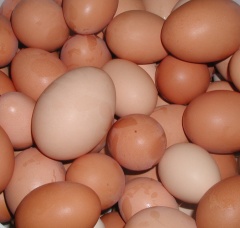Eggs
| Infobox on Eggs | |
|---|---|
| Example of Eggs |  |
| Facts | |
| Origin | - |
| Stowage factor (in m3/t) | 2,83 m3/t (cases) Stow away from odorous cargo |
| Humidity / moisture | - |
| Ventilation | - |
| Risk factors | See text |
Eggs
Contents
Description
Eggs are laid by females of many different species, including birds, reptiles, amphibians, and fish, and have been eaten by mankind for thousands of years. Bird and reptile eggs consist of a protective eggshell, albumen (egg white), and vitellus (Egg Yolk), contained within various thin membranes. Popular choices for egg consumption are chicken, duck, quail, roe, and caviar, but the egg most often consumed by humans is the chicken egg, by a wide margin.
Egg yolks and whole eggs store significant amounts of protein and choline, and are widely used in cookery. Due to their protein content, the United States Department of Agriculture (USDA) categorizes eggs as Meats within the Food Guide Pyramid. Despite the nutritional value of eggs, there are some potential health issues arising from egg quality, storage, and individual allergies.
Chickens and other egg-laying creatures are widely kept throughout the world, and mass production of chicken eggs is a global industry. In 2009, an estimated 62.1 million metric tons of eggs were produced worldwide from a total laying flock of approximately 6.4 billion hens. There are issues of regional variation in demand and expectation, as well as current debates concerning methods of mass production, with the European Union's ban on battery farming of chickens.
Egg white coagulates, or solidifies, when it reaches temperatures between 62.2 and 65°C. Egg yolk coagulates at slightly higher temperatures, between 65 and 70°C.
If a boiled egg is overcooked, a greenish ring sometimes appears around egg yolk due to the iron and sulfur compounds in the egg. It can also occur with an abundance of iron in the cooking water. The green ring does not affect the egg's taste; overcooking, however, harms the quality of the protein. Chilling the egg for a few minutes in cold water until it is completely cooled may prevent the greenish ring from forming on the surface of the yolk.
Cooking also increases the risk of atherosclerosis due to increased oxidization of the cholesterol contained in the egg yolk.











